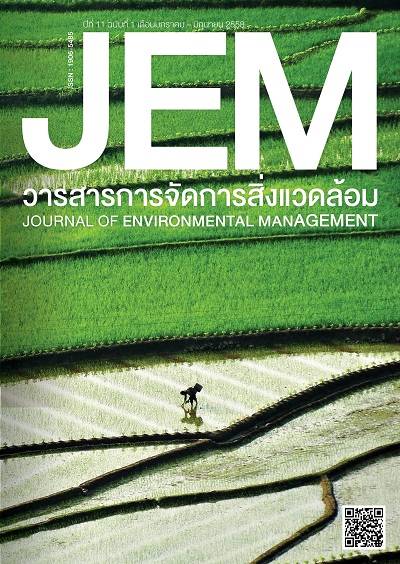ภาพอนาคตเพื่อการวางแผนจัดการทรัพยากรธรรมชาติและสิ่งแวดล้อมอย่างยั่งยืน Scenario Analysis for Sustainable Natural Resources and Environmental Planning
DOI:
https://doi.org/10.14456/jem.2015.7บทคัดย่อ
การพัฒนาอย่างยั่งยืนเป็นเป้าหมายหลักในการพัฒนาของสังคมโลกในปัจจุบัน เพื่อแก้ไขวิกฤติการณ์ปัญหาสิ่งแวดล้อมที่เกิดจากการพัฒนาที่มุ่งเน้นเฉพาะการเจริญเติบโตทางเศรษฐกิจ โดยใช้ทรัพยากรธรรมชาติอย่างเข้มข้นจนเกินขีดจำกัด เพื่อเพิ่มปริมาณการผลิตสินค้าและบริการให้ตอบสนองกับความต้องการที่ฟุ่มเฟือยตามกลไกการตลาดและการพัฒนาของเทคโนโลยี ซึ่งการพัฒนาอย่างยั่งยืนจะต้องตอบสนองต่อความต้องการของคนในรุ่นต่อไปเทียบเท่ากับคนในรุ่นปัจจุบัน โดยให้ความสำคัญกับมิติของเวลาไม่ยิ่งหย่อนไปกว่ามิติด้านปริมาณ และคุณภาพของทรัพยากรธรรมชาติและสิ่งแวดล้อม ดังนั้น ในการตัดสินใจเพื่อดำเนินการพัฒนาอย่างยั่งยืนจึงต้องมีการวางแผนอย่างรอบคอบ โดยคำนึงถึงผลกระทบที่จะเกิดขึ้นในอนาคตด้วย ทั้งนี้ รายละเอียดของการสร้างภาพของสิ่งที่จะเกิดขึ้นในอนาคต โดยเฉพาะในบริบทของการวางแผนจัดการทรัพยากรธรรมชาติและสิ่งแวดล้อมยังไม่มีการจัดทำเป็นเอกสารวิชาการภาษาไทยอย่างชัดเจน บทความนี้จึงทำการทบทวนเอกสารที่เกี่ยวข้องกับนิยามและลักษณะของภาพอนาคต รวมทั้งกระบวนการสร้างภาพอนาคต พร้อมตัวอย่างการประยุกต์ใช้ในกรณีศึกษาในประเด็นการพัฒนาประเทศไทย พลังงานของประเทศไทย และการพัฒนาในระดับจังหวัดของจังหวัดสมุทรสงคราม วิเคราะห์เปรียบเทียบข้อเด่นและข้อด้อยของเทคนิค พร้อมอภิปรายผล เพื่อเป็นแนวทางในการประยุกต์ใช้เทคนิคการสร้างภาพอนาคตในการตัดสินใจวางแผนจัดการทรัพยากรธรรมชาติและสิ่งแวดล้อมอย่างยั่งยืนต่อไป
Sustainable development is now the main goal for any development in the global society, in order to solve the environmental crises caused by the development that only aims at economic growth. Natural resources are intensively over-exploited in order to increase the number of products and services to serve the extravagant needs of the market forces and technology development. The goal of sustainable development is to respond to the needs of future generations as being equal to those of the present generation, i.e. the time dimension is as highly respected as aspects of the quality and quantity of natural resources and the environment. Hence, in any decision regarding development, careful planning that takes into account the impact on the future is needed. However, the applications of scenario analysis on natural resources and environmental planning are not well documented, especially in the Thai language. This article, therefore, gathered relevant documents regarding the definitions and characteristics of scenarios and scenario analysis. Applications of the scenarios analysis technique regarding the development of Thailand, Thailand’s energy, and the provincial development of Samut Songkhram province are presented, and the strengths and weaknesses of the technique are discussed. The findings can serve as a guideline for applying the scenario analysis technique to natural resources and environmental planning in a sustainable path.
เอกสารอ้างอิง
Alcamo, J. (ed.) (2009). Environmental Futures: The Practice of Environmental Scenario Analysis. Amsterdam Elsevier.
Chermack, T., Lynham, S. & Ruona, W. (2001). A Review of Scenario Planning Literature.
Futures Research Quarterly, 17(2), 7-31. Retrieved June 20, 2014, from
http://www.thomaschermack.com/Thomas_Chermack_-_Scenario_Planning/Research_files/ ReviewofSP.PDF
Coordination Centre for Community-based Research, Samut Songkhram. (2012). Sub Global Assessment-Ecosystem Services, Human Well-Being and Sustainable Development in Samut Songkhram Province. [In Thai: รายงานโครงการการประเมินคุณประโยชน์ของระบบนิเวศ ความอยู่ดีมีสุขของประชาชน และการพัฒนาอย่างยั่งยืนในจังหวัดสมุทรสงคราม]. Retrieved July 19, 2014, from http://www.peithailand.com/sga_report/SGASamut%20Songkhram%20Report.pdf
Cosgrave, W. & Rijsberman, F. (2000). World Water Vision: Making Water Everybody’s Business.
London: Earthscan/Thanet Press.
Damrongchai, N., Bodhisuk, P. & Srirathanaban, C. (2008). Scenarios. In C. Srirathanaban, N. Damrangchai, P. Bodhisuk, S. Thongsopit & P. Satangput (eds.), Research Project on Scenarios and Road Map toward Sustainable Health Insurance System in Thailand. [In Thai: โครงการวิจัยการศึกษาภาพอนาคตและเส้นทางสู่หลักประกันสุขภาพถ้วนหน้าที่ยั่งยืนของประเทศไทย]. Health Insurance System Research Office. Retrieved July 1, 2014, from http://www.hisro.or.th/main/modules/research/attachideology/147/Full-text.pdf
Energy Research Institute, Chulalongkorn University. (2013). A Summary of Assumption and Quantitative
Scenarios of Thailand’s Energy in 20 Years. [In Thai: สรุปสมมติฐานและการจำลองภาพอนาคตพลังงาน
ไทยเชิงปริมาณในอีก20 ปีข้างหน้า]. Retrieved July 19, 2014, from
http://www.eri.chula.ac.th/eri-main/wp-content/uploads/2013/04/20-__________.pdf
European Environment Agency. (2001). Environmental Issue Report No 24: Scenarios as Tools for International Environmental Assessments: Experts' Corner Report: Prospects and Scenarios No 5. Copenhagen: European Environment Press. Retrieved June 15, 2014, from
http://www.eea.europa.eu/publications/environmental_issue_report_2001_24/page001.html
Fahey, L. & Randall, R.M. (eds). (1998). Learning from the Future: Competitive Foresight Scenarios.
New York: John Wiley & Sons.
Gallopı´n, G., Hammond, A., Raskin, P. & Swart, R. (1997). Branch Points: Global Scenarios and Human Choice. Pole Star Series Report No. 7. Stockholm, Sweden: Stockholm Environment Institute. Retrieved June 20, 2014, from http://www.sei-international.org/mediamanager/documents/ Publications/Future/branch_points.pdf
Intergovernmental Panel on Climate Change. (2000). Emissions Scenarios. Cambridge: Cambridge
University Press. Retrieved June 20, 2014, from
https://www.ipcc.ch/pdf/special-reports/emissions_scenarios.pdf
Knowledge Network Institute of Thailand. (2010). Thailand Scenarios 2019. [In Thai: ภาพอนาคตประเทศไทย
. Retrieved July 19, 2014, from
http://eportfolio.hu.ac.th/library/images/stories/Bookonline/thailand2562.pdf
Lebel, L. (2010). UNDP SGA Technical Note 9: Building scenarios together. Retrieved June 15, 2014, from
http://www.peithailand.org/en/document/note/UNDP%20SGA%20Technical%20Note%209%20-
%20Building%20scenarios%20together.pdf
Malaska, P. & Virtanen, I. (2005). Theory of Futuribles. Futura, 2-3, 10-28. Retrieved July 1, 2014, from
http://lipas.uwasa.fi/~itv/publicat/Futuribles.pdf
Mekprayun, M. (translator). (1994). Agenda 21 for Sustainable Development: A Summary of Agenda 21
on Environment and Development. [In Thai: แผนปฏิบัติการ 21 เพื่อการพัฒนาอย่างยั่งยืน สรุป
สาระสำคัญของ Agenda 21 ในเรื่องสิ่งแวดล้อมกับการพัฒนา]. Bangkok: Ministry of Foreign Affairs.
Millennium Ecosystem Assessment. (2005). Ecosystems and Human Well-being: Scenarios, Volume 2.
Washington, DC: Island Press. Retrieved June 15, 2014, from
http://www.unep.org/maweb/en/Scenarios.aspx
Ministry of Natural Resources and Environment. (2009) Strategic Environmental Assessment. [In Thai:
การประเมินสิ่งแวดล้อมระดับยุทธศาสตร์]. Office of Natural Resources and Environmental Policy and
Planning Bangkok: BV Offset Publisher.
Office of the National Economic and Social Development Board. (2003). Document for Annual Report on Sustainable Development in Thai’s Context. [In Thai: เอกสารประกอบการประชุมประจำปี
การพัฒนาที่ยั่งยืนในบริบทไทย]. Retrieved July 1, 2014, from http://www.nesdb.go.th/Portals/0/news/annual_meet/46/docu/data06.zip
OSCE (Organization for Security and Co-operation in Europe) & EEA (European Energy Agency). (2012). Using Scenarios to Improve Understanding of Environment and Security Issues. Copenhagen: EEA. Retrieved June 15, 2014, from http://www.eea.europa.eu/publications/using-scenarios-brochure-2012/download
Peterson, G. D., Cumming, G. S. & Carpenter, S. R. (2003). Scenario Planning: A Tool for Conservation in an Uncertain World. Conservation Biology, 17, 358–366.
Sasin Graduate Institute of Business Administration, Chulalongkorn University. (2012). The Final Report:
The Long Term Strategy for Enhancement and Conservation of National Environmental Quality
Project (Phase 1) [In Thai: รายงานฉบับสมบูรณ์ โครงการกำหนดยุทธศาสตร์ระยะยาวในการส่งเสริมและ
รักษาคุณภาพสิ่งแวดล้อมของประเทศ (ระยะที่1)]. Retrieved July 19, 2014, from
http://www.onep.go.th/download/ 2013june19_final_report.pdf
Scenarios to Strategy Inc. The scenario planning process. Retrieved June 15, 2014, from http://scenarios2strategy.com/docs/planning.html
Thailand Environment Institute. (2012). Report on the Sub-global Assessment (SGA) for Nan, Thailand.
[In Thai: รายงานการประเมินระบบนิเวศสู่การอยู่ดีมีสุขและกำหนดทางเลือกการพัฒนาในจังหวัดน่าน].
Retrieved July 19, 2014, from http://www.peithailand.com/sga_report/SGA-Nan%20Report.pdf
United Nations. (1987). Report of the World Commission on Environment and Development: Our Common Future. New York: United Nations. Retrieved June 15, 2014, from http://www.un-documents.net/our-common-future.pdf
United Nations Environment Programme. (2007). Global Environmental Outlook 4. Malta: Progress Press. Retrieved June 15, 2014, from http://www.unep.org/geo/geo4/report/geo-4_report_full_en.pdf
van der Heijden, K. (1996). Scenarios: The Art of Strategic Conversation. New York: John Wiley & Sons.
Retrieved July 30, 2014, from http://www.untagsmd.ac.id/files/Perpustakaan_Digital_1/
CREATIVE%20 THINKING%20Scenarios,%20The%20art%20of%20strategic%20conversation.pdf
Wulf, T., Meißner, P., & Stubner, S. (2010). A Scenario-based Approach to Strategic Planning – Integrating Planning and Process Perspective of Strategy. Retrieved July 30, 2014, from http://www.hhl.de/fileadmin/texte/publikationen/arbeitspapiere/hhlap0098.pdf



